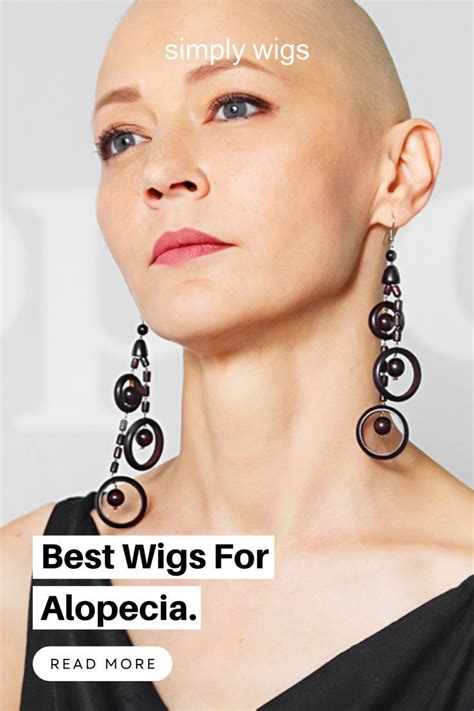Introduction

Alopecia, a condition characterized by hair loss, can be a challenging experience for individuals. Wigs offer a discreet and versatile solution to manage hair loss while enhancing self-confidence. This comprehensive guide explores three types of wigs for alopecia, their benefits, and styling tips to help you navigate this journey.
1. Synthetic Wigs for Alopecia: Versatile and Budget-Friendly
- Key Features: Machine-made from synthetic fibers; durable, easy to care for, and affordable.
-
Benefits:
- Wide range of styles, colors, and textures to match individual tastes.
- Heat-resistant up to 180-250°F, allowing for versatile styling.
- Less maintenance required compared to human hair wigs.
-
Styling Tips:
- Use professional-grade heat tools specifically designed for synthetic wigs.
- Avoid excessive heat styling to prevent fiber damage.
- Utilize dry shampoo and wig brushes to maintain freshness and remove tangles.
2. Human Hair Wigs for Alopecia: Natural and Customisable
- Key Features: Crafted from ethically sourced human hair; breathable, comfortable, and luxurious.
-
Benefits:
- Natural appearance and texture, providing a seamless blend with your own hair.
- Customizable options such as hair length, density, and color for a truly personal look.
- Can be styled with heat tools, offering endless styling possibilities.
-
Styling Tips:
- Use gentle hair care products formulated for human hair.
- Invest in a wig stand or mannequin head for proper storage and drying.
- Seek professional assistance from a wig stylist or salon for advanced styling techniques.
3. Lace Front Wigs for Alopecia: Undetectable Confidence
- Key Features: Hand-tied or machine-made with high-quality lace; create an illusion of natural hair growth.
-
Benefits:
- Undetectable hairline, ensuring a realistic and flawless appearance.
- Breathable and comfortable, suitable for sensitive scalps.
- Can be customized with intricate lace detailing for a seamless blend.
-
Styling Tips:
- Use specialized lace glue or tape to secure the wig securely.
- Trim the lace around the hairline for a natural and invisible look.
- Experiment with different lace patterns and hairlines to find the most flattering style.
Table 1: Comparison of Wig Types for Alopecia
| Feature | Synthetic Wig | Human Hair Wig | Lace Front Wig |
|---|---|---|---|
| Material | Synthetic fibers | Human hair | Lace and human hair |
| Durability | Machine-made, durable | Breathable, comfortable | Hand-tied or machine-made |
| Cost | Affordable | Expensive | Premium pricing |
| Maintenance | Easy care | Requires gentle products | Specialized care |
| Styling | Heat-resistant, versatile | Endless styling options | Undetectable hairline |
| Appearance | Machine-made appearance | Natural appearance | Seamless blend |
Table 2: Benefits of Wigs for Alopecia
| Benefit | Description |
|---|---|
| Increased Confidence | Boosts self-esteem and reduces anxiety associated with hair loss. |
| Style Versatility | Offers a wide range of styles, colors, and textures to match individual tastes. |
| Hair Protection | Protects sensitive scalps from sun damage, wind, and pollution. |
| Comfort and Convenience | Provides a comfortable and discreet way to manage hair loss. |
| Customization Options | Allows for tailored solutions, including hair length, density, and color. |
Table 3: Styling Tips for Wigs
| Tip | Rationale |
|---|---|
| Use professional heat tools | Protects wig fibers and ensures safe styling. |
| Invest in wig care products | Maintains wig longevity and freshness. |
| Avoid excessive washing | Over-washing can damage fibers and reduce wig lifespan. |
| Store wigs properly | Ensures wig shape and prevents tangles. |
| Seek professional assistance | Ensures proper fit, styling, and maintenance. |
Table 4: Key Statistics on Alopecia
| Statistic | Relevance |
|---|---|
| 6.5 million Americans | Number of people affected by alopecia areata, the most common type of alopecia. |
| 100,000 new cases per year | Estimated number of new cases of alopecia areata. |
| 40% of people | Percentage of individuals with alopecia areata who experience total hair loss. |
| 80% of cases | Percentage of alopecia areata cases that occur before the age of 40. |
Conclusion
Wigs provide an invaluable solution for individuals experiencing alopecia. Whether you choose synthetic, human hair, or lace front wigs, there is a style and type to suit your needs and preferences. By embracing the versatility and confidence-boosting benefits of wigs, you can navigate your alopecia journey with style and grace. Remember, hair loss does not define your worth, and with the right wig, you can reclaim your sense of self-expression and live life to the fullest.
